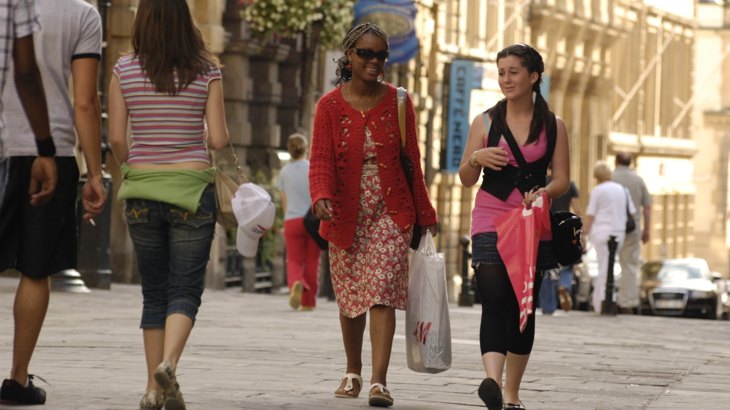Both main political parties have committed to building 1.5 million homes over the next five years. While headlines have often focused on whether new homes will hit these impressive numbers, how we build these homes might be the more important question.

We want to see thriving places where people have the choice to walk, wheel or cycle for day to day journeys. Credit: Sustrans
Too often, sprawling housing developments have been built without public transport links or basic amenities.
This builds over large areas of countryside and forces people into car-dependency or a feeling of isolation.
It’s not just organisations like Sustrans saying this.
People living near these developments often oppose them.
This is because they eat up vast swathes of green space and put more cars on local roads.
And this opposition can further reduce the number of homes that get built.
In short, if the UK is to build the promised number of homes, this needs to be done differently.
A new report from Sustrans and Create Streets sets out what this could look like.
Stepping Off the Road to Nowhere uses a real-life proposed development in Chippenham, Wiltshire, where 7,500 new homes have been planned, served by a new £75m road.
Our report shows how better design and investment decisions – based on ‘gentle density’ and sustainable transport – can deliver the same number of homes on just 40% of the land.
Planning for active travel
Traditional transport planning for new developments assumes residents will drive for most journeys.
This requires parking and large roads to cater for these new trips.
Experience shows new roads tend to lead to more traffic.
There is a growing movement towards taking an alternative, ’vision-led’ approach.
This takes a different angle by asking the local community what they want for their neighbourhood and how they want to get around, designing places and new transport infrastructure according to this ‘vision’.
We think this is important.
In our study, the £75m designated for a new road was diverted to public transport, walking, wheeling and cycling, crucial funding for town centre improvements supporting local businesses.

Our report shows how better design and investment decisions can deliver the same number of homes on just 40% of the land.
More homes on less land
‘Gentle density’ is another key principle in our report.
In contrast to low-density sprawl, gentle density means building low and midrise buildings arranged on a well-connected network of streets and public spaces to get the most out of the land.
In practice, this means more characterful, better overlooked streets, squares and parks.
Typically there is more terraced housing and fewer detached homes in cul-de-sacs.
In the Chippenham example used in our study, taking this approach would use just 40% of the land designated in original plans, for the same number of homes.

Our report proposes investing some of the road money to support the establishment of local businesses and services, reducing the need for car travel. Credit: Sustrans.
A blueprint for a thriving town
We want to see thriving places where people have the choice to walk, wheel or cycle for day-to-day journeys.
Where streets are designed so the public realm serves people of all ages, abilities, means and needs.
In our report, we propose investing some of the road money to support the establishment of local businesses and services, reducing the need for car travel.
Such a scheme is likely to be popular, with successive surveys showing most people want to live in places where they can reach basic amenities within a short return walk.
Extrapolated to the 1.5 million promised new homes, the approach taken in our study could transform new developments across the country.
Stepping Off the Road to Nowhere comes at a real turning point.
Will the next wave of housebuilding eat up large swathes of countryside and lock millions more into the car as their only transport option?
Or will housebuilding targets be unattainable in the face of local opposition?
We hope a third outcome is possible: thriving new neighbourhoods, welcomed by existing residents, built in a way which enables healthy lifestyles and lower carbon emissions.
About the report
Stepping Off the Road to Nowhere was generously supported by The Rees Jeffreys Road Fund and the Foundation for Integrated Transport.
Any errors or omissions are the authors’ sole responsibility.
The report reflects the views of the authors and not necessarily those of The Rees Jeffreys Road Fund or the Foundation for Integrated Transport.
Download the full report 'Stepping Off the Road to Nowhere'.





